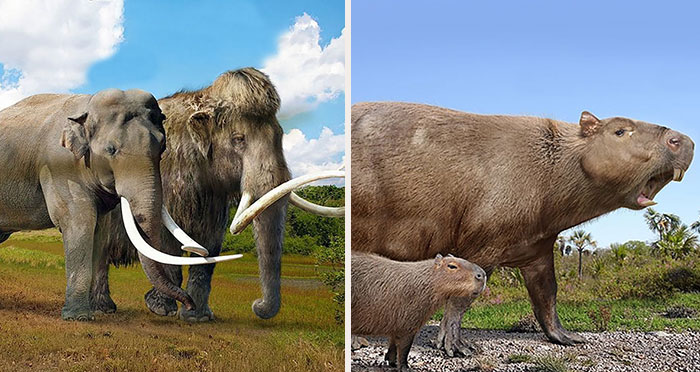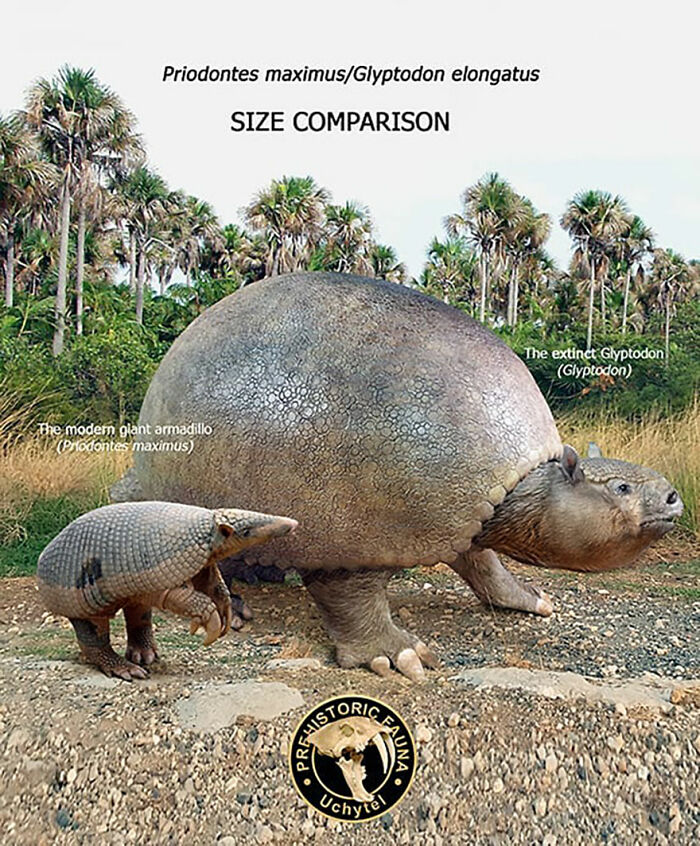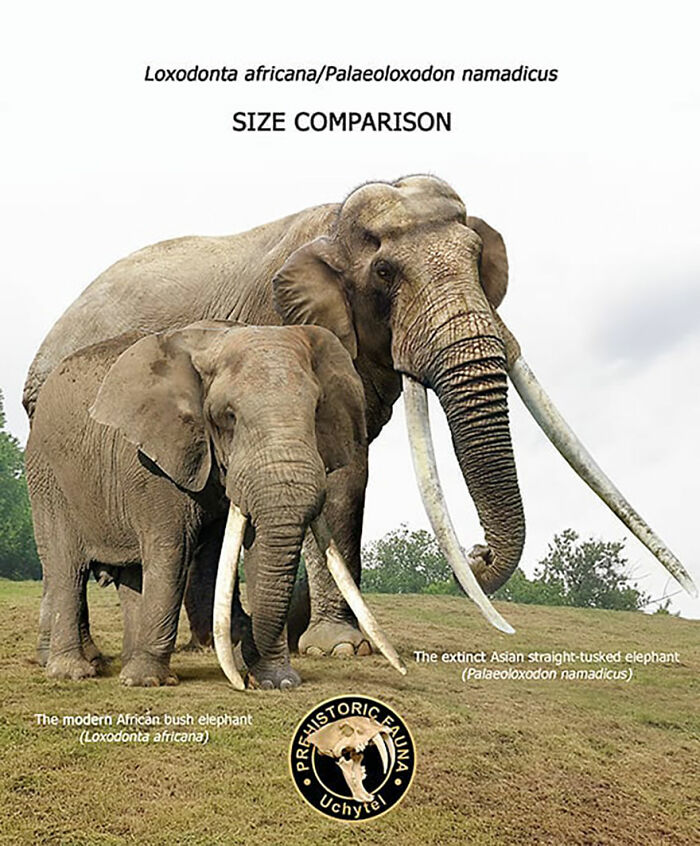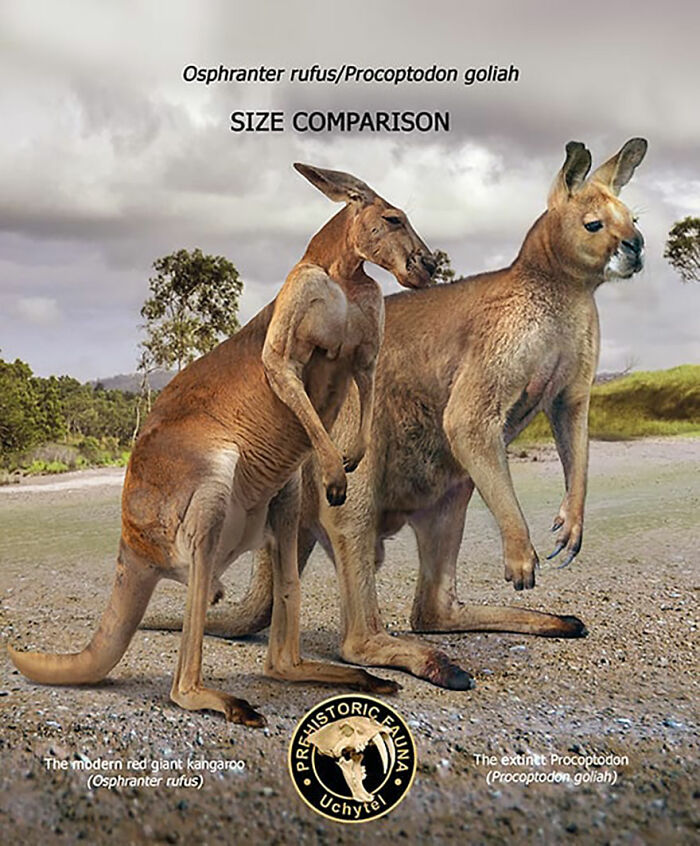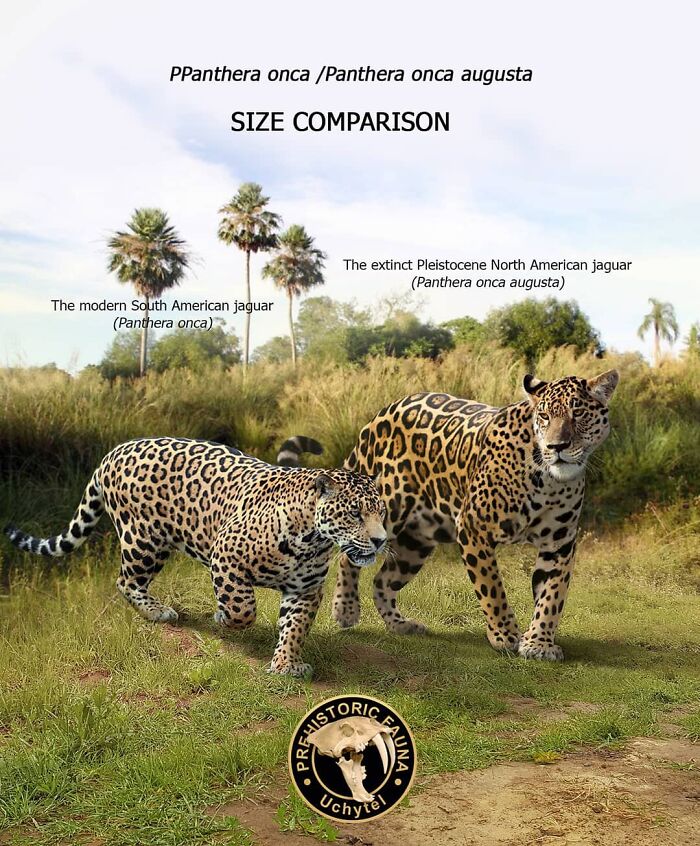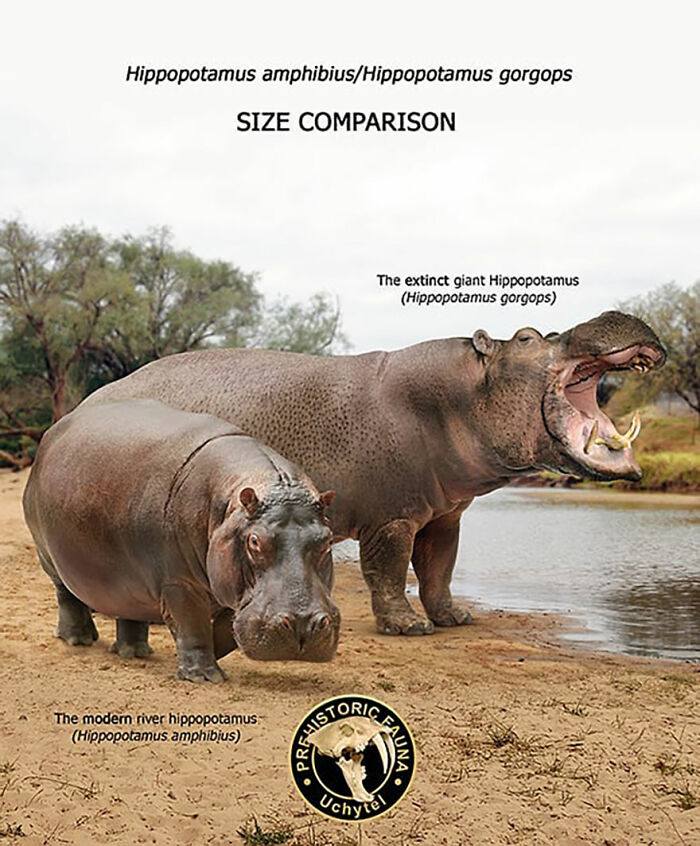
791Kviews
37 Comparisons Of The Sizes Of Prehistoric Animal Ancestors And Their Modern Relatives By Roman Uchytel
Interview With ArtistModern technology does not only let us enjoy the things that are in the present, but also things from the past. The software available, like Photoshop, helps us take a glimpse at what things looked like. Even though they still remain digital, they're pretty close to reality.
Roman Uchytel uses technology for this very reason. He uses Photoshop to show us a glimpse of things that have passed and most likely will never come back. To be more specific, he recreates prehistoric extinct species of animals as best as he can using the information that he has. And it's fair to say that he's been doing a pretty good job at it; he even published a book which you can find here.
For today's post, we show you only one of many of his series, where he compares the sizes of extinct species with their modern relatives and places them side by side. It's really surprising how some of the species were way bigger than you would've thought looking at their modern kin.
More info: twitter.com | prehistoric-fauna.com | Facebook | Instagram
This post may include affiliate links.
Most of the animals shown here existed during the Pleistocene, otherwise known as Ice Age era, which lasted from around 2.58 million to 11m7 thousand years ago. As the term Ice Age signifies, it was a glacial period where most of the northern hemisphere was covered in, you guessed it, ice. The glaciations happened on and off in steady cycles which lasted from 41,000 to 100,000 years.
It looks like the smaller shark told a great joke to the larger one....
As you probably know by now, all of the ancestor species shown here are extinct. Almost all, if not all of these species went extinct in the so-called Quaternary period (2.58 million years before the present) in the Late Pleistocene. This period is marked by numerous megafaunal and other extinctions. This pulse extinction is characterized by the fact that there was a widespread absence of ecological successors, which caused a major shift in faunal habitats and relationships.
Fact: life on Earth has suffered 5 major extinction events, and is going through one so-called Holocene extinction event right now. An extinction event is a widespread and rapid decrease in biodiversity. The greatest extinction event killed 90 to 96 per cent of all species. Scientists argue over the exact number of extinction events life has gone through, ranging from five to as many as twenty. The current extinction event is different from others because human activity plays a huge hand in it.
Let's hope you learned something new today. If you didn't, or if you're up to learn even more cool stuff, Bored Panda is here to help you satisfy this thirst for knowledge. Here's our latest edition of "Today I Learned" posts that our community loves. Too general, want to learn something more animal-centric? No problem. Want to know more about silly bird names that ornithologists came up with? Or perhaps you want to know what insects really look like when they're flying? Let's not end this post about extinct species with a sad note: here's a story about reappeared elephant shrew species that we thought went extinct 50 years ago.
Roman shared: "My favorite animal is the one I’m drawing right now. So every time I get a new favorite. Can you imagine that ancient rodents were the size of a rhinoceros, and extinct rhinos led the life of giraffes and were the tallest animals in the world?!"
"My wife and business partner Alexandra Antonova (Uchytel) is a great writer. She has so many cool ideas. Now we’re working on one idea—Prehistories (a series of prehistoric fairy tales). Now all we have to do is find a publisher."
Why does the extinct cheetah look like an annoyed older sibling XD
My local dinosaur museum has a prehistoric crocodile's skull on display, and the damn thing is the size of a smartcar! Thank goodness they're not around any more - modern crocodiles are scary enough!
I guess. Hippos kill more people than wolves, sharks, elephants and lions combined.
Load More Replies...Happy to be corrected, apparently even though a hippo is large in size, they are remarkably fast at running. Faster than the average human I believe.
You're right....the average human cannot outrun a hippo, which is why they kill so many people yearly. You think because they're so adorably pudgy and awkward looking you can get close and just run away...but they will catch you.
Load More Replies...Love hyenas, their lineage and modern characteristics, especially the perfection of their heads and muzzles. Same for the South American Jaguar and its ancestors ( pictured above). When something works so well, not much needs to change.
I wonder if the giant gelada grazed on grass like the modern one?
Great thread. It might have been nice to add a common factor to see the scale of the animals. Like a solute representing a human for example. (Not a banana for scale people…)
This was really cool. Sad that it didn't get a lot of traffic. I was thinking about why animals have shrunk so much, and then I remembered reading an article in Discover magazine a couple of years ago about how creatures grown in carbon dioxide rich/lower oxygen atmospheres grow much bigger. I think back in the day, that was the earth's atmosphere and as oxygen levels have risen over millennia, the animal world has shrunk. So as we continue to churn out carbon dioxide with more people, and wipe down forest land, will we go back to that ancient atmosphere and end up with giant animals again?
Yes and no. There was a moment in time where oxigen levels were higher, allowing animals like insects to be big (like the Carboniferous). But its not the case here. Most of this animals got extinct as a combination of prehistoric human hunting and the end of the ice age.
Load More Replies...Many of the extinct animals shown here were the victims of over-hunting and human-caused habitat destruction. Wherever Homo sapiens arrived, mass extinctions of the megafauna quickly followed.
There's far more to it than was thought, and humans had little to do with many of the extinctions. A huge part of the Northern Hemisphere used to be a single, massive, tundra habitat which spread unbroken across continental Europe and Asia. The sheer size of this habitat allowed the megafauna to survive despite climate fluctuations. When this habitat was replaced with warmer forests and grasslands, then the megafauna had nowhere to go and died out. A similar, but somewhat more complex picture, was true in the Americas, but it is widely accepted that humans did little more than give the final push to species that were functionally extinct.
Load More Replies...I think scientist are trying to work on this. They are harvesting mammoth DNA so they can bring something back. But if successful the creature won't be perfect. Look it up! 🙂
Load More Replies...It would be interesting to see the "first dog". Like when did you decide it is a dog, not a tamed wolf.
It would look similar to a grey wolf. If you are interested in the topic. https://www.smithsonianmag.com/science-nature/how-wolves-really-became-dogs-180970014/
Load More Replies...Yes loved this article but now can we have a "what would some creatures look like speculatively in the future" version of this? Please!
You cant. Their looks will depend on how their future environment is and random luck like which mutations they get and which species evolve and not just get extinct.
Load More Replies...So basically the extincts ones are bigger and fluffier versions of the modern ones ?
Many species were smaller, they just showed big ones. For example in italy there used to be pigmy elephants. Google sicilian dwarf elephant
Load More Replies...This is interesting! I agree with what others are saying about a common factor for scale. Though I think my nightmares would be fuelled by the visual of a human beside the megalodon!
This was great! It's funny how people are scared of these modern animals, but they used to be so much scarier. Especially the giant death birds.
Yes, animals used to be bigger, it makes sense.......there weren't billions of humans on the Planet Earth at that time to plunder it.
This was fascinating. Some of these animals really haven't changed that much.
Having better weather when glaciers retreated would not have made any of these animals 100% die off. If they needed cold for some odd reason they could have simply gone north. There's still plenty of cold and snow in the vast Artic. Do you really think the small number of human hunters, who only had bows and spears not guns, could have wiped out 100% of every single large mammal? These beasts were very large and powerful. Humans were wimpy in comparison. That is not reasonable. Even with guns and a stated goal of wiping out all bison to starve the indians, hunters were unable to make bison extinct. Its not possible fewer men with shorter range, less powerful weapons, and less able to travel could have been able to wipe out 100% of everything. Animals would simply go somewhere farther away and pockets of population would survive and repopulate. The extinction of largest versions of animals fits perfectly with the global Flood account. Much easier to preserve smaller varieties.
If you're really bored, Panda, include some invertebrates, if you can find them.
Definitely need the size of something for perspective, at least the sizes of the modern animals.
Genuinely terrified of how much bigger animals were back in the day. But I am glad they have been able to adapt with the times (Most of them).
They werent able to become smaller. The ones that got extinct just never could adapt to the hunting pressures of humans. We killed most of this, its not a good thing that they are gone.
Load More Replies...And, yet nothing on the huge 15 to 30-foot humans that use to roam the earth too. And, yet there are old photographs that still exist of extremely tall humans that nose existed that had no diseased bones. So, it was normal.
You mean the very obviously faked photographs? That we somehow lost the bones of and have never rediscovered any examples of, despite tens of thousands of archaeologists working all over the world?
Load More Replies...Many of the animals shown are cousins, rather than direct ancestors. And we do indeed have megafauna cousins, like gorillas.
Load More Replies...Great thread. It might have been nice to add a common factor to see the scale of the animals. Like a solute representing a human for example. (Not a banana for scale people…)
This was really cool. Sad that it didn't get a lot of traffic. I was thinking about why animals have shrunk so much, and then I remembered reading an article in Discover magazine a couple of years ago about how creatures grown in carbon dioxide rich/lower oxygen atmospheres grow much bigger. I think back in the day, that was the earth's atmosphere and as oxygen levels have risen over millennia, the animal world has shrunk. So as we continue to churn out carbon dioxide with more people, and wipe down forest land, will we go back to that ancient atmosphere and end up with giant animals again?
Yes and no. There was a moment in time where oxigen levels were higher, allowing animals like insects to be big (like the Carboniferous). But its not the case here. Most of this animals got extinct as a combination of prehistoric human hunting and the end of the ice age.
Load More Replies...Many of the extinct animals shown here were the victims of over-hunting and human-caused habitat destruction. Wherever Homo sapiens arrived, mass extinctions of the megafauna quickly followed.
There's far more to it than was thought, and humans had little to do with many of the extinctions. A huge part of the Northern Hemisphere used to be a single, massive, tundra habitat which spread unbroken across continental Europe and Asia. The sheer size of this habitat allowed the megafauna to survive despite climate fluctuations. When this habitat was replaced with warmer forests and grasslands, then the megafauna had nowhere to go and died out. A similar, but somewhat more complex picture, was true in the Americas, but it is widely accepted that humans did little more than give the final push to species that were functionally extinct.
Load More Replies...I think scientist are trying to work on this. They are harvesting mammoth DNA so they can bring something back. But if successful the creature won't be perfect. Look it up! 🙂
Load More Replies...It would be interesting to see the "first dog". Like when did you decide it is a dog, not a tamed wolf.
It would look similar to a grey wolf. If you are interested in the topic. https://www.smithsonianmag.com/science-nature/how-wolves-really-became-dogs-180970014/
Load More Replies...Yes loved this article but now can we have a "what would some creatures look like speculatively in the future" version of this? Please!
You cant. Their looks will depend on how their future environment is and random luck like which mutations they get and which species evolve and not just get extinct.
Load More Replies...So basically the extincts ones are bigger and fluffier versions of the modern ones ?
Many species were smaller, they just showed big ones. For example in italy there used to be pigmy elephants. Google sicilian dwarf elephant
Load More Replies...This is interesting! I agree with what others are saying about a common factor for scale. Though I think my nightmares would be fuelled by the visual of a human beside the megalodon!
This was great! It's funny how people are scared of these modern animals, but they used to be so much scarier. Especially the giant death birds.
Yes, animals used to be bigger, it makes sense.......there weren't billions of humans on the Planet Earth at that time to plunder it.
This was fascinating. Some of these animals really haven't changed that much.
Having better weather when glaciers retreated would not have made any of these animals 100% die off. If they needed cold for some odd reason they could have simply gone north. There's still plenty of cold and snow in the vast Artic. Do you really think the small number of human hunters, who only had bows and spears not guns, could have wiped out 100% of every single large mammal? These beasts were very large and powerful. Humans were wimpy in comparison. That is not reasonable. Even with guns and a stated goal of wiping out all bison to starve the indians, hunters were unable to make bison extinct. Its not possible fewer men with shorter range, less powerful weapons, and less able to travel could have been able to wipe out 100% of everything. Animals would simply go somewhere farther away and pockets of population would survive and repopulate. The extinction of largest versions of animals fits perfectly with the global Flood account. Much easier to preserve smaller varieties.
If you're really bored, Panda, include some invertebrates, if you can find them.
Definitely need the size of something for perspective, at least the sizes of the modern animals.
Genuinely terrified of how much bigger animals were back in the day. But I am glad they have been able to adapt with the times (Most of them).
They werent able to become smaller. The ones that got extinct just never could adapt to the hunting pressures of humans. We killed most of this, its not a good thing that they are gone.
Load More Replies...And, yet nothing on the huge 15 to 30-foot humans that use to roam the earth too. And, yet there are old photographs that still exist of extremely tall humans that nose existed that had no diseased bones. So, it was normal.
You mean the very obviously faked photographs? That we somehow lost the bones of and have never rediscovered any examples of, despite tens of thousands of archaeologists working all over the world?
Load More Replies...Many of the animals shown are cousins, rather than direct ancestors. And we do indeed have megafauna cousins, like gorillas.
Load More Replies...
 Dark Mode
Dark Mode 

 No fees, cancel anytime
No fees, cancel anytime 


